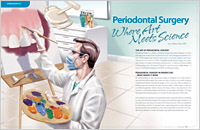Do you have zero cavities? Then you’re lucky, but how are your gums? Gum disease can be sneaky. Without healthy bone and gum tissue, the structures that hold your teeth, feed your smile nutrients and keep it healthy are in jeopardy. Gum disease in its earliest stages is called gingivitis. If it isn’t treated early, you could be looking at gum disease. Gum disease causes receding gums and bone loss until your teeth become loose to the point it may feel uncomfortable when you’re biting or chewing, putting your smile in danger.
Gingivitis is subtle and can occur without you even knowing it. Maybe you haven’t been as diligent with brushing and flossing. Perhaps you’re a smoker. But other conditions contribute to gingivitis too. If you’re a diabetic, under extreme stress, pregnant or taking certain medications, gingivitis can happen to you. Studies have also revealed that you can be genetically predisposed to gum disease as well.
At the earliest stages, your gums appear red and swollen. Red and swollen gums simply mean there is plaque buildup under your gumline and between your teeth. It’s simply your body’s way of reacting to the bacteria and the irritation it causes. Your gums could also bleed while brushing and flossing. Again, bleeding gums is your body’s reaction to an infection, but it’s also a clear sign of the beginning stages of gum disease.
As bacteria grow your gums pull away from your teeth. Receding gums form these pockets along the gum line, making it easier for the bacteria to attach to teeth, causing gum recession and eventually exposing the bone underneath. Other signs that plaque and bacteria are jeopardizing your gum health are bad breath or sensitivity whenever you drink or eat something hot or cold.
Break down biofilm with PerioRenew
Unhealthy gums can dramatically impact more than just your smile. Learn more about this revolutionary new gel for gum disease.
sponsored ad
Yes, you can. At its earliest stages, you can reverse the early signs of gum disease by becoming more diligent with flossing, brushing and using a tongue scraper. Tongue scrapers can be found at drugstores, but even toothbrushes are now designed with a tongue scraper. If there isn’t one handy, popsicle sticks work in a pinch. Your six-month checkups become 3-month cleanings to see how you’re progressing. Besides better oral hygiene, use a plaque-removing mouthwash, change your toothbrush every 3 months and keep brushes as clean as possible.
Break down biofilm with PerioRenew
Unhealthy gums can dramatically impact more than just your smile. Learn more about this revolutionary new gel for gum disease.
sponsored ad
As an oral infection, gingivitis can be reversed before it becomes periodontal disease. Periodontal disease, in its advanced stages, requires major procedures to treat bone loss or tooth loss. Procedures like gum grafting to reverse gum recession or bone grafting to replace bone loss are just a few of the treatments offered to repair missing teeth and bone due to periodontal disease. If your gum infection isn’t chronic, then none of these procedures are needed.
Besides better brushing and flossing, root planing and scaling is the best way to remove plaque buildup below the gum line. This non-surgical therapy shrinks your gum pockets, closing gaps between your teeth and gums–the very place bacteria hide to do the most damage to your smile.
It’s actually a non-invasive gum therapy treatment. Since red, inflamed gum tissue can be sensitive, you may want a local anesthetic to numb the area. Scaling and root planing are two methods that reverse the early signs of gum infection. Scaling gently scrapes away tartar and plaque below the gumline using both hand instruments and an ultrasonic device. The device emits these sonic vibrations, removing tartar and plaque from the tooth’s surface, while root planing smoothes the rough edges of the root surface. Plaque and tartar no longer have anything to cling to keeping infection away. This deep cleaning decreases the inflammation and plaque buildup bringing your gums back to a natural, healthy pink color.
Aftercare for scaling and root planing is simple. There is a prescription mouthwash and desensitizing paste to use with a soft-bristle toothbrush to gently care for your teeth and gums. Since flossing would only aggravate swelling, a gentle rinse or a water-pik can help keep the area clean as possible.
Within one week, you will see a noticeable difference in the color of your gums. At this point, you should see less bleeding and inflammation as well.
Now your pearly whites have pink, pretty gums as the background to a brilliant smile. All that’s needed is diligent oral hygiene and regular check-ups and you’re on your way to having a healthy smile for life.
 Periodontal Surgery – Where Art Meets Science
Periodontal Surgery – Where Art Meets Science
This article is an overview of how the art of plastic surgical procedures and the science of periodontics can enhance the health and beauty of your teeth. You will learn what periodontal surgery is designed to do, what makes it successful and what to expect during treatment… Read Article
Gum DiseasegumssurgeryGingivitisRoot Planing and Scalingroot planingscaling
Source: Reverse the Early Signs of Gum Disease Without Surgery

